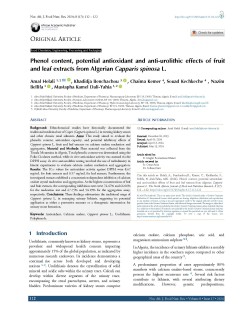Phenol content, potential antioxidant and anti-urolithic effects of fruit and leaf extracts from Algerian <i>Capparis spinosa</i> L.
Abstract
Background: Ethnobotanical studies have historically documented the traditional medicinal use of Caper (Capparis spinosa L.) in treating kidney stones and other chronic renal ailments.
Aims: This study aimed to evaluate the phenolic content, antioxidant capacity, and potential inhibitory effects of Capparis spinosa L. fruit and leaf extracts on calcium oxalate nucleation and aggregation.
Material and Methods: Plant material was collected from the Tessala Mountains in Algeria. Total phenolic content was determined using the Folin-Cioclateu method, while in vitro antioxidant activity was assessed via the DPPH assay. In vitro anti-urolithic testing involved the use of turbidimetry in kinetic experiments to evaluate calcium oxalate nucleation and aggregation.
Results: The IC50 values for antioxidant activity against DPPH were 8.67 mg/mL for fruit extracts and 0.57 mg/mL for leaf extracts. Furthermore, the investigated extracts exhibited a concentration-dependent inhibition of calcium oxalate crystal nucleation and aggregation. At the highest concentrations of leaf and fruit extracts, the corresponding inhibition rates were 74.47% and 66.06% for the nucleation test and 67.75% and 54.19% for the aggregation assay, respectively.
Conclusions: These findings substantiate the traditional usage of Capparis spinosa L. in managing urinary lithiasis, suggesting its potential application as either a preventive measure or a therapeutic intervention for urinary stone formation.
Full text article
Authors
Copyright (c) 2024 Amal Helali, Khadidja Benchachou , Chaima Kemer, Souad Kechkeche, Nazim Bellifa , Mustapha kamel Dali-Yahia

This work is licensed under a Creative Commons Attribution 4.0 International License.
-
Attribution — You must give appropriate credit, provide a link to the license, and indicate if changes were made. You may do so in any reasonable manner, but not in any way that suggests the licensor endorses you or your use.
-
No additional restrictions — You may not apply legal terms or technological measures that legally restrict others from doing anything the license permits.





